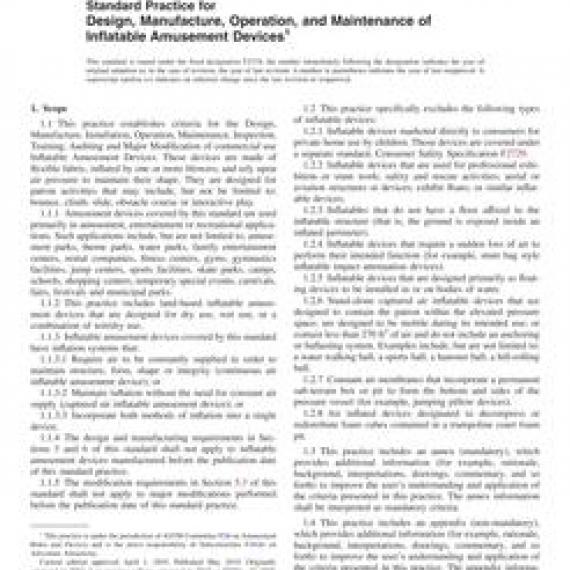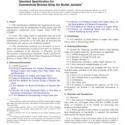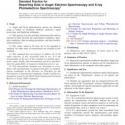No products
ASTM F2374-19
ASTM F2374-19 Standard Practice for Design, Manufacture, Operation, and Maintenance of Inflatable Amusement Devices
standard by ASTM International, 04/01/2019
Full Description
1.1This practice establishes criteria for the Design, Manufacture, Installation, Operation, Maintenance, Inspection, Training, Auditing and Major Modification of commercial use Inflatable Amusement Devices. These devices are made of flexible fabric, inflated by one or more blowers, and rely upon air pressure to maintain their shape. They are designed for patron activities that may include, but not be limited to: bounce, climb, slide, obstacle course or interactive play.
1.1.1Amusement devices covered by this standard are used primarily in amusement, entertainment or recreational applications. Such applications include, but are not limited to, amusement parks, theme parks, water parks, family entertainment centers, rental companies, fitness centers, gyms, gymnastics facilities, jump centers, sports facilities, skate parks, camps, schools, shopping centers, temporary special events, carnivals, fairs, festivals and municipal parks.
1.1.2This practice includes land-based inflatable amusement devices that are designed for dry use, wet use, or a combination of wet/dry use.
1.1.3Inflatable amusement devices covered by this standard have inflation systems that:
1.1.3.1Require air to be constantly supplied in order to maintain structure, form, shape or integrity (continuous air inflatable amusement device); or
1.1.3.2Maintain inflation without the need for constant air supply (captured air inflatable amusement device); or
1.1.3.3Incorporate both methods of inflation into a single device.
1.1.4The design and manufacturing requirements in Sections 5 and 6 of this standard shall not apply to inflatable amusement devices manufactured before the publication date of this standard practice.
1.1.5The modification requirements in Section 5.3 of this standard shall not apply to major modifications performed before the publication date of this standard practice.
1.2This practice specifically excludes the following types of inflatable devices:
1.2.1Inflatable devices marketed directly to consumers for private home use by children. Those devices are covered under a separate standard, Consumer Safety Specification F2729.
1.2.2Inflatable devices that are used for professional exhibition or stunt work; safety and rescue activities; aerial or aviation structures or devices; exhibit floats; or similar inflatable devices.
1.2.3Inflatables that do not have a floor affixed to the inflatable structure (that is, the ground is exposed inside an inflated perimeter).
1.2.4Inflatable devices that require a sudden loss of air to perform their intended function (for example, stunt bag style inflatable impact attenuation devices).
1.2.5Inflatable devices that are designed primarily as floating devices to be installed in or on bodies of water.
1.2.6Stand-alone captured air inflatable devices that are designed to contain the patron within the elevated pressure space; are designed to be mobile during its intended use; or contain less than 270 ft of air and do not include an anchoring or ballasting system. Examples include, but are not limited to: a water walking ball, a sports ball, a hamster ball, a hill-rolling ball.
1.2.7Constant air membranes that incorporate a permanent sub-terrain box or pit to form the bottom and sides of the pressure vessel (for example, jumping pillow devices).
1.2.8Air inflated devices designated to decompress or redistribute foam cubes contained in a trampoline court foam pit.
1.3This practice includes an annex (mandatory), which provides additional information (for example, rationale, background, interpretations, drawings, commentary, and so forth) to improve the users understanding and application of the criteria presented in this practice.The annex information shall be interpreted as mandatory criteria.
1.4This practice includes an appendix (non-mandatory), which provides additional information (for example, rationale, background, interpretations, drawings, commentary, and so forth) to improve the users understanding and application of the criteria presented in this practice.The appendix information shall not be interpreted as mandatory criteria.
1.5This standard does not purport to address all of the safety concerns, if any, associated with its use. It is the responsibility of the user of this standard to establish appropriate safety, health, and environmental practices and determine the applicability of regulatory limitations prior to use.
1.6This international standard was developed in accordance with internationally recognized principles on standardization established in the Decision on Principles for the Development of International Standards, Guides and Recommendations issued by the World Trade Organization Technical Barriers to Trade (TBT) Committee.


































